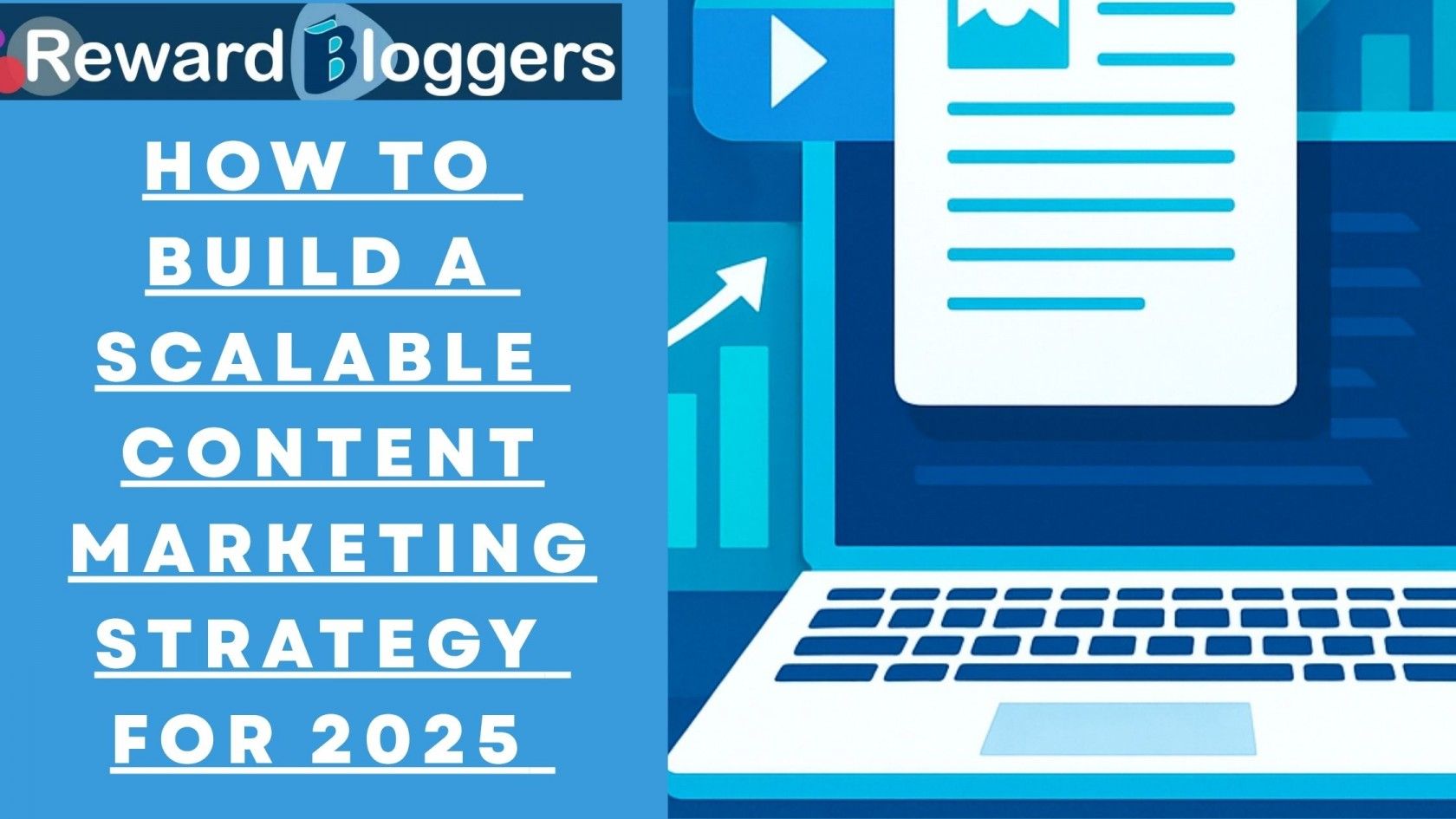Discover how to build a scalable content marketing strategy for 2025 and beyond. This step-by-step guide breaks down what content marketing is, why it still matters, and how to create a plan that grows with your business. Learn how to choose the right content types, tools, and platforms, and how to make your strategy SEO-friendly. Whether you're a small business, solo creator, or marketer, this article helps you build a strategy that saves time, increases reach, and delivers real results. Start scaling your content with smart planning and modern tools that work in today's digital world.
Content marketing in 2025 is more than blogs and social media updates—it's how you build a smart strategy that grows with your brand. If you're an owner of a small business, startup, or personal brand, creating content without a strategy to go along with it can be time and money-consuming. That's where scalable content marketing strategy comes in.
This blog will show you what a content marketing strategy is, why it is still valid in 2025, and how to develop one that will endure. You will learn how to select the best kinds of content, where to share them, and how to use tools to develop faster. Most importantly, we will illustrate how to make your content plan simple to manage, no matter how high your aspirations are.
Ready to build your brand with great content? Let's break it down into easy steps anyone can follow—even if you're new to this.
What is a Content Marketing Strategy?
A content marketing strategy is a plan for how you'll produce, distribute, and keep up helpful content that will attract and retain customers. It will include things such as:
What you'll be writing about
Who your audience is
Where you'll be publishing your content
How often will you publish
Why your content matters to your audience
Why Will Content Marketing Still Matter in 2025?
Here are some reasons why content marketing will remain very important in 2025:
People look online first before they buy.
Trust is built through helpful, authentic content.
Google prefers websites with great, helpful content.
Social media needs content in order to be alive and grow.
No matter what changes in tech or trends, people will always want helpful information. That’s why a strong strategy is needed.
If you’re serious about creating content that performs well, it’s essential to understand how search engines rank pages. This simple and complete guide to How Google Search works explains the process in a beginner-friendly way and can help you create content that ranks better.
Who Needs a Scalable Content Marketing Strategy?
Scalable means something that can grow without breaking. So if you’re asking, “Who should build a scalable content marketing strategy?”, the answer is simple: anyone who wants to grow online.
This includes:
Small businesses
E-commerce stores
Startups
Non-profits
Coaches, bloggers, and influencers
Even solo creators need a plan they can keep up with as their audience grows.
How to Build a Scalable Content Marketing Strategy (Step-by-Step)
Let’s break it down into simple steps anyone can follow.
Step 1: Know Who You’re Creating Content For
Ask yourself:
Who is my ideal reader or customer?
What do they care about?
Where do they spend time online?
Use Google search suggestions, social media comments, and surveys to get to know your audience. The more you understand them, the better your content will be.
Step 2: Determine What Kind of Content You Will Create
There are many forms of content, including:
Blog posts
Videos
Infographics
Podcasts
Social media posts
Ebooks and guides
Choose those that your followers like and that you can create regularly. Don't try to do everything. Focus on what is working.
Step 3: Determine Where You'll Post and Share Your Content
You should know:
Where your audience hang out (e.g., Instagram, YouTube, Google, LinkedIn)
Where your content will live (e.g., your site, blog, YouTube channel)
Make sure that your website is your main content hub. Then, cross-post your articles on platforms where your audience is most active.
Step 4: Develop a Content Calendar
A calendar keeps you sane. It tells you:
What to publish
When to publish
Where to publish
Utilize free tools like Google Sheets, Trello, or Notion. Posts schedule weekly or monthly, and plan ahead for holidays, events, or product launches.
Step 5: Make Your Content SEO-Friendly
If you want your content to show up on Google, listen to the following SEO tips:
Use words people are looking for (like "how to build a content strategy")
Subheadings and short paragraphs
Link to other helpful pages
Add images and alt text
Keep it easy and readable
If you're looking to distribute your content beyond your own site and gain quality backlinks, check out this list of the top 50 free article submission websites with instant approval. It's a great resource for boosting your content visibility and improving search rankings.
Step 6: Take Advantage of Tools and Automation
To scale your strategy without exhausting yourself:
Create graphics with Canva
Proofread using Grammarly or Hemingway
Use AI tools to help with content concepts
Schedule posts on Buffer, Later, or Hootsuite
These tools will make you smarter and more efficient.
Choosing the right tools is key to scaling your strategy. Not sure which SEO tool to invest in? This detailed comparison of SEMrush vs Ahrefs in 2025 breaks down the pros and cons to help you decide which one suits your needs best.
Step 7: Track What's Working (and What Isn't)
You should also know:
What content is most watched
Where people are clicking
Which content generates sales or sign-ups
Use Google Analytics or social insights to measure outcomes. Then repeat what's working and optimize or cut what isn't.
Where Will Content Marketing Go in the Future?
This is what to expect in the coming years:
More short videos (Reels, Shorts, TikToks)
Better AI content writing tools
Greater focus on quality, rather than quantity
Voice and visual search will grow
Google will keep rewarding helpful content
So ask yourself: Where will your content sit in this future? Start creating now.
What Will Make Your Strategy Scalable?
A scalable strategy is one that:
Doesn't make you work 24/7
Can scale with more teammates or tools
Keeps on giving in the long term
Easily reusable, repurposable, or updatable
This is how smart brands save time, money, and hassle while still growing.
Final Thoughts
Crafting a scalable content marketing strategy in 2025 is easy—but it does take planning, commitment, and the right tools. The key is to stay simple, be steady, and grow incrementally.
Ask yourself:
What is my audience searching for?
Who am I helping with my content?
How can I keep making my strategy even better?
If you can say yes to those questions, you're better off.
FAQs About Content Marketing Strategy in 2025
Q1: What is a scalable content marketing strategy?
A scalable content strategy is a flexible plan that enables you to scale your content without burning out. It can handle more subjects, more platforms, and more people as your brand grows.
Q2: Why will content marketing still matter in 2025?
Content marketing builds trust, provides answers, and allows individuals to discover you using search engines. So long as humans browse online, content will be important.
Q3: Who needs to adopt a content marketing strategy?
All those who want to grow their online following—companies, freelancers, bloggers, influencers, or coaches—need a content strategy to succeed.
Q4: How do I know what type of content I should produce?
Start with questioning what your audience needs. Leverage search engine suggestions, social media, and analytics to see what people are looking for.
Q5: Where do I share my content?
Share on your website or blog first. Next, share it on social networks, YouTube, email newsletters, or where your community gathers.





